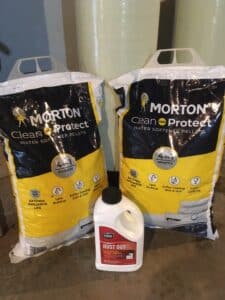Using the correct salt for your softener is important but there are different types of softeners available and this impacts the type of salt required. Water softeners can usually be divided into two categories:
- Softeners with synthetic resin. (This type is by far the most common.)
- Softeners with Zeolite resin (Common softener brands may include Sanitizer Plus and Evolve series EV1 and EV2, or a softener tank labeled to contain Crystal-Right resin.)
Softeners containing synthetic resin

If you have a softener with synthetic resin, the best salt to use would be “salt pellets”.
-
- Salt pellets are the cleanest form of salt. Using salt pellets keeps sludge from building up in the brine tank.
- As an industry standard, salt pellets are sold in yellow bags. Many brands are available in this pellet form.
At Aquanology, we recommend the brand, Morton Clean and Protect, for its quality and stability.
- Salt pellets are the cleanest form of salt. Using salt pellets keeps sludge from building up in the brine tank.

- Solar salt is also an option for synthetic-resin softeners. Since it is a little less expensive per pound of salt, this is the reason it is so popular.
However, since solar salt has higher levels of impurities, over time sludge will build up in your brine tank. Therefore, if using solar salt, it is important to clean out your brine tank periodically.
Softeners containing Zeolite resin
Zeolite resin is not compatible with many common softener additives. Therefore, proper care for this kind of system is especially critical.
- Only solar salt crystals should be used in these systems. Solar salt is widely available in many brands, and the industry standard is a blue and/or white bag.
- NO salt pellets (yellow bag), iron-removing salt pellets (green bag), or other salt with cleaners should be used.
- NO Iron Out or any acid cleaners should be used.
Water Quality and Softener Performance
Water quality may affect your softener’s performance. Check your water source for these potential issues:
Iron
- Iron in your water, often identified by those brown-orange stains, can foul a water softener. If you have iron, a twin tank softener is usually recommended for optimum performance.
- If you have high iron, a powder form of iron cleaner (Iron Out brand or similar product) will help keep your softener clean and functioning properly, plus aid in iron removal.
- Rust Remover or similar brand of salt pellets, which come industry standard in a green bag, may also help reduce iron buildup, but we do not recommend it.

Dirt & Sand
Dirt, sand, and other particles or debris can cause havoc in your softener. This happens when particles become lodged in the control valve and keep your softener from regenerating properly. The good news is, usually a simple cartridge particle filter ahead of your system will provide a quick fix for this problem. However, in cases of extremely dirty water, it may be necessary to have a specialist give recommendations.
Bacteria
Bacteria and other microbiologicals can be harmful to your softener. If you have problems with bacteria or are unsure whether you have bacteria in your water, contact Aquanology, and we can help you find answers.
PH
The pH of your water can also affect your softener’s performance; however, as is the case with bacteria, there is no one-size-fits-all fix for this problem. If in doubt about your water system’s performance, feel free to give Aquanology a call, and we’ll be happy to help.
Maintaining the correct level of salt in your water softener
In any softener, the salt level in the brine tank/barrel should always exceed the water level. Water levels in brine tanks may vary across different softeners but generally, water comes up about 6″- 12″ in the bottom of your brine tank. Therefore, a good rule of thumb would be this: “Don’t let your brine tank deplete to less than 1/3 full.”
In the event that your softener runs out of salt, you can take these measures to replenish your system with salt to ensure proper hardness removal.
- Fill the brine tank with salt.
- Wait 4 hours. This allows the salt to create the brine solution.
- Manually regenerate the system, according to manufacturer specs. This may take several hours.
- If you have a twin tank system, repeat steps 2 & 3.
Do you want to avoid thinking about what kind of salt your water softener requires? Is handling those heavy bags of salt out of your comfort zone? Aquanology can deliver salt, and/or fill your brine tank, all as a part of our scheduled maintenance plan. Learn more by contacting us today.
Disclaimer
This blog is intended to be used only as a general guide for what type of salt your water softener requires and should not override manufacturers’ recommendations. Please read your owner’s manual.
For the best interest of your softener’s performance and durability, you should have your water tested by a specialist. Aquanology will gladly provide you with this service. Feel free to contact us at any time.
For more information on your water quality concerns, reach out to us today.
Get In Touch
Embrace the change towards cleaner, safer water with Aquanology’s water purification systems. Contact us today to find the perfect solution for your home.







